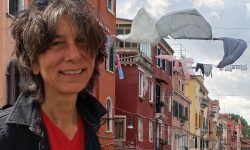1
With this exhibition at the Vetrina in Venice, and its title, a cross between Swiss Alpine flora and the gastronomy of the Lagoon… Edelweiss al Nero di Seppia… we’ve come full circle, so to speak. Your Italian origins, Switzerland, your life in Zurich, Geneva and Lausanne, your interest in food and the animal and plant worlds, it’s all there?
This title creates a bridge between two cultural areas, and also between two senses, the visual and the gustatory. By moving from one language to another, in this case from German to Italian, and by using words that are familiar to everyone, without the need for translation, Edelweiss al Nero di Seppia refers to identities that marked my youth, as the child of Italian immigrants, I grew up in Zurich. Multiculturalism, present from the outset, was a key factor. During my school years, I added the languages of Shakespeare and Molière, opening my imagination to new horizons. Then came bits and pieces of languages from other countries too, learnt on the job during my stays abroad. This borderless linguistic geography gives me the feeling of living in languages rather than countries.
Being in the world means being in touch with what it contains. There are millions of different forms of life on earth, which have evolved over 3.5 million years. Like evolution, creation is unpredictable. The possibilities are endless. With my work on the flowers I observed in Switzerland, or on the animals to which I feel strangely connected, I don’t claim to have a complete vision of the world. Rather, I’m aware of a world that is constantly evolving, that is on an adventure, and that inevitably drags me along with it
2
You use a wide range of artistic techniques, Claudia, from collage to video, drawing to painting. There are no boundaries, there’s an insatiable curiosity in you, a desire to explore different worlds and techniques?
We come from a past whose origins we’re still looking for, and we’re heading for a future whose end we don’t know. My artistic approach is situated in this half-open space, between knowledge, the quest for knowledge and uncertainty. I mentally move towards places that also move me. I need to see and learn constantly, to perceive differently, and I need to modify what surrounds me. It is probably in collage that the dimension of transformation is most perceptible: an image is removed from one context and integrated into another, giving it a new relevance. The past and the present coexist in this way, giving rise to a new, unexpected meaning.
3
You’re also a publisher, and in 2022 you set up Editions LaClac: with artists’ badges, but also fanzines and postcard series like ‘Labyrinthes’. You invited artists to illustrate the age-old theme of the maze. Is contemporary creation and the collective environment important to you?
LaClac was set up by a group of artists with the idea of creating new and experimental publishing projects and forging links between artistic worlds that don’t usually come together. With this in mind, we design productions that bring together artists from different backgrounds around a proposed theme or a common medium. The project of badges designed by the artists, produced in limited editions and sold at a low price, has met with a remarkable response from a wide audience. We owe this success to the artists, through their generous participation, and to the museum institutions willing to distribute these nuggets of art in their bookshop-boutiques. The result is a community unlike any other, transcending the boundaries between different artistic positions and backgrounds.
4
You highlight contemporary artists, but you also pay homage to older figures, such as Marcel Duchamp in your videos, or Niki de Saint-Phalle. Is surrealism and feminism a rhyme that speaks to you?
Whether ancient or contemporary, through their works artists are the repositories of knowledge, technical innovations and the history of their time. Without them, what would I know about colour production, invented in prehistoric times? Or about the linear perspective that revolutionised the way the West saw the world? I’m also thinking of the countless painted portraits that give a face to the world before the invention of photography, and make the absent present, as Leon Battista Alberti put it. For me, old paintings are not dead images. Their contemporaneity lies in their ability to continually provoke wonder.
‘Works of art are infinitely solitary’, said Rilke. To reassure myself, I think of the artists I admire, whose lives have been masterpieces of solitude.


